#Family: Parulidae
Explore tagged Tumblr posts
Text



#poll#Class: Aves#Order: Passeriformes#Family: Parulidae#Genus: Setophaga#Setophaga Ruticilla#Range: Nearctic#Range: Neotropical
105 notes
·
View notes
Note
Is there a bird that can make me happy again
THIS BIRD WILL SOLVE ALL OF YOUR PROBLEMS!!!

Pink-headed Warbler (Cardellina versicolor), family Parulidae, found in Chiapas, Mexico and Guatemala
photograph by danialdschumann

photograph by Francesca Albini

photograph by Forrest Rowland
1K notes
·
View notes
Text
Genus: Setophaga
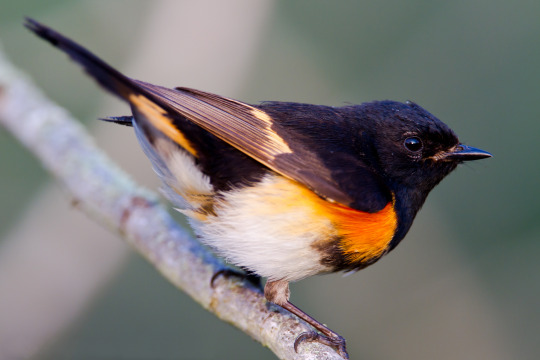
Originally, this genus was only used for the American Redstart (Setophaga ruticilla). Meaning 'moth-eater', it was used to refer to the flycatcher-like habits of the American Restart, which sallies forth from a perch to catch flying insects rather than plucking them from vegetation.
In 2010, however, a newly published paper disrupted what was thought of Parulidae taxonomy. Using a comprehensive molecular phylogenetic analysis of the family, several genus were merged into Setophaga. Not only that, but a separate genus of warbler was cleaved in two based on the findings.
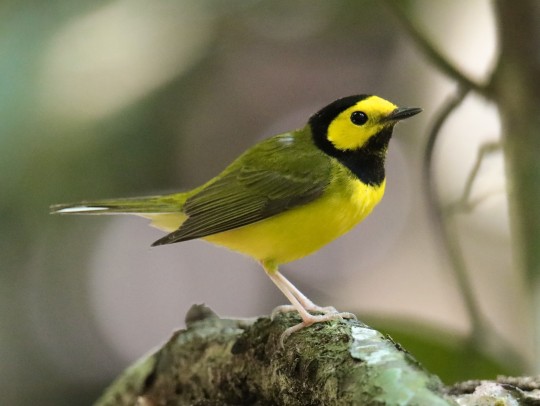
The Hooded Warbler was previously listed under the genus Wilsonia along with Wilson's Warbler and Canada Warbler. They had even been in an obsolete genus together before this (Sylvania), though this was changed to Wilsonia for other reasons. The 2010 study showed that Wilsonia was polyphyletic, meaning the group may share similar traits, but do not share a common ancestor. Hooded Warbler was moved to Setophaga and Wilson's and Canada Warbler were placed into Cardellina, an existing genus with Red-faced, Pink-headed, and Red Warbler.

The two Parula species were also folded into Setophaga as a result of the 2010 study. The Northern and Tropical Parula were originally the only two members of this genus, with the Northern Parula being the type-specimen of New World Warblers as a whole. I find that a bit ironic, as they are one of the smallest warblers and show quite an unusual color patter when compared to the rest of Parulidae, but I don't exactly know how type-specimen are chosen.

The largest genus to be merged with Setophaga was Dendroica. When I first began learning species names, I was familiar with this as the genus for most warblers. Due to the way taxonomic names work, the name which was published first takes precedent in these merging scenarios. So, despite the fact Dendroica had around 30 species and Setophaga had just 1, Setophaga was published first in 1827 (Dendroica in 1842).
In summary, Setophaga went from just a single species to now being the largest in the Parulid family, holding 34 species!
Image Sources: AMRE (Dan Pancamo); HOWA (Ninahale); NOPA (Dan Pancamo); MAWA (Cephas)
#setophaga#parulidae#passeriformes#bird#north american birds#american birds#american redstart#hooded warbler#northern parula#magnolia warbler#(had to include MAWA in there they're babyyyy)#(also hi I'm wikipedia now I guess. linking to other wiki pages within my own article like damn lol)#Genus Feature
70 notes
·
View notes
Note
Do you have any favorite birds?
Ohhhh man this question is so hard!!!!! I love so many birds that it's hard to pick. Here's a few of the ones I'm always thrilled to see:
Roseate Spoonbill (Platalea ajaja)
These guys use their spoon-shaped bills to filter-feed on microorganisms in the water! Just like the much-loved species of flamingo, their pink coloration is derived from their diet of crustaceans and other invertebrates!
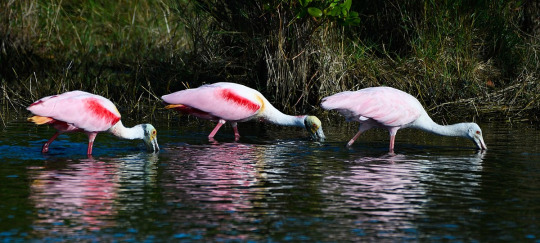
(via)
Ruddy Turnstone (Arenaria interpres)
Much like their name implies, ruddy turnstones turn over rocks along the shores to find invertebrates to feed on! Their breeding plumage is just gorgeous.

(via)
Aaaand since I do call myself a passerine ornithologist, I better toss in a songbird lest they come to take my credentials away!
Ovenbird (Seiurus aurocapilla)
My first venture into field research was with these, frankly, huge warblers. They're much larger than the other members of their family (Parulidae) and dwell on the ground far more often than some of their relatives! They get their name from the shape of their nests, which look like little pizza ovens!

(via)
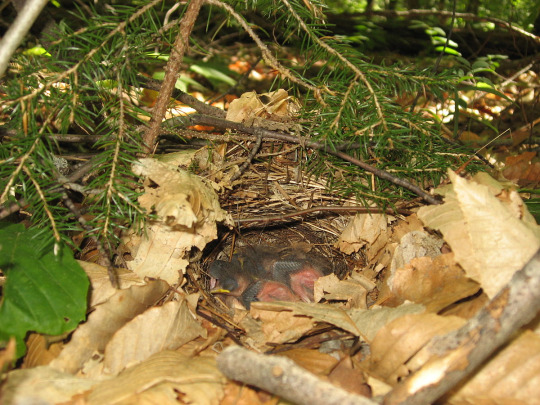
(via)
#aquila answers#birds#pelecaniformes#threskiornithidae#platalea ajaja#charadriiformes#scolopacidae#Arenaria interpres#passeriformes#parulidae#seiurus aurocapilla
5 notes
·
View notes
Text















Picture(s) of the Day: Cape May Warbler
Setophaga tigrina
ORDER: Passeriformes
FAMILY: Parulidae
A lot of them I know, but it was so rare to not only locate the Cape May we were hearing but to see and, even more rare, to get the chance to photograph him! There was something on that limb that he really enjoyed.
Did you know: (via Cornell Lab's All About Birds) The average clutch size of the Cape May Warbler (6 eggs) is greater than that of other warblers. This large clutch size may allow Cape May Warbler populations to expand rapidly during outbreaks of their preferred prey, spruce budworms.
2 notes
·
View notes
Video
Yellow-breasted Chat ..."Buffoon of the Briar Patch"1437 crop MCSP Southern California by Pekabo Via Flickr: "The chat is a true birder’s bird. Most non-birding members of the general public have probably never even heard of this species, and few would ever find themselves in the right kind of place to stumble upon one by chance. Yellow-breasted Chats can be challenging to find even with dedicated search effort, largely owing to their preference for densely vegetated, brushy habitat with nearly impenetrable tangles. Once discovered, however, they display animated antics that have charmed many a naturalist. Their jaunty, cocked tails and prominent white spectacle markings lend them a distinctive, expressive appearance, further enhanced by the boldly contrasting plumage of the brilliant golden throat, the clean white underbelly, and the camouflaged olive-green of the upperparts. Though they are frequently skulky and silent during migration and the winter months, Yellow-breasted Chats can be shockingly conspicuous in the breeding season. Males post up on high perches, belting out chaotic, improvisational songs that feature a blend of hoots, growls, whistles, chatters, purrs, cackles, mewls, squawks, and mimicry of other species. They regularly launch into an impressive song flight, flapping dramatically with exaggerated tail pumps all while constantly vocalizing in midair. These musical performances sometimes continue long into the dark of the night, which may help passing nocturnal migrants locate suitable habitat on the ground below. With this varied repertoire of bizarre noises taken into account, the “chat” portion of the species moniker is clearly every bit as apt as “yellow-breasted” is. One of the most intriguing details about this species is the turbulent history of its taxonomic classification. For decades, Icteria virens was designated a member of the wood-warbler family Parulidae, but it was understandably considered to be an aberrant outlier. This placement never quite sat right with many birders and ornithologists, as the chat’s structure and behavior are so wildly different from anything else in the tribe. Nebulous comments in field guides and checklists that the bird “might not belong” were a gross oversimplification of more than a century of scientific disagreements about its true affinities. In-depth genetic studies of New World passerines revealed that the Yellow-breasted Chat inhabits a distinct branch of the tree of life that is sister to the family Icteridae, which includes blackbirds, orioles, meadowlarks, oropendolas, and others. Some authorities have assigned the chat to that family as well, but the American Ornithological Society presently recognizes the species as the sole representative of a monotypic family: Icteriidae. " nemesisbird.com
#Icteria virens#Yellow-breasted Chat#Reinita Grande#Ictérie polyglotte#not a warbler#new gear#canon R7#200-800#birdwatching Los Angeles#Malibu creek state park birds#might sing at night#weirdo#flickr
0 notes
Text

Chestnut-sided Warbler (Setophaga pensylvanica), male, family Parulidae, order Passeriformes, Cuyahoga Valley National Park, OH, USA photograph by Joshua Clark
0 notes
Text

Cerulean warbler
The cerulean warbler (Setophaga cerulea) is a small songbird in the family Parulidae. It is a long-distance migrant, breeding in eastern North American hardwood forests. In the non-breeding season, it winters on the eastern slope of the Andes in South America, preferring subtropical forests.
0 notes
Text

The golden-fronted whitestart or the golden-fronted redstart, is a species of bird in the family Parulidae. It is found in forest, woodland and scrub in the Andes of Colombia and far western Venezuela.
0 notes
Text


Decided to coin two more genders based off of these :3
Coracigender // Paruligender
Coracigender: pangender but masc and fem genders are the strongest and neutral genders are the weakest
Paruligender: pangender but neutral genders are the strongest, masc and fem genders are weakest
Kept the bird theme, based on the Coraciidae family aka the Roller birds, which are blue and pink, and the Parulidae family, aka the Warbler birds, which are mostly yellow. I was thinking of canaries instead but I didnt want both of them starting with C



flag id: two flags with 7 stripes. the left flag's stripes are dull light purple-pink, pale purple-pink, white, very light yellow, light red-orange, turquoise, and medium dark turquoise. the right flag's stripes are dull light turquoise, pale turquoise, white, very light yellow, light red-orange, bright purple-pink, and medium dark dark purple-pink. end id.
banner id: a 1600x200 teal banner with the words ‘please read my dni before interacting. those on my / dni may still use my terms, so do not recoin them.’ in large white text in the center. the text takes up two lines, split at the slash. end id.
sialigender | galahgender
sialigender: a pangender experience in which feminine genders are very weak and masculine genders are strongest
galahgender: a pangender experience in which masculine genders are very weak and feminine genders are strongest
[pt: sialigender: a pangender experience in which feminine genders are very weak and masculine genders are strongest
galahgender: a pangender experience in which masculine genders are very weak and feminine genders are strongest. end pt]
anon asked for the first term and i figured i'd coin its inverse! the flags use colors adjusted from the pangender flag and colors representing masculine and feminine genders, with the weaker gender's color desaturated and the stronger gender's color very saturated.
the terms are based on eastern bluebirds (sialia sialis) and galah birds, since eastern bluebirds are mostly blue with red accents and galahs are pink and silver, which i felt fit the color schemes!
tags: @radiomogai, @liom-archive, @macchiane, @genderstarbucks, @sugar-and-vice-mogai
tags cont: @prettypinknarc, @skrimbliest, @fem-mogai
dni link
#sialigender#galahgender#pangender#mingender#fingender#coined terms#@neopronouns#mogai coining#lgbtq#lgbt#trans flags#liom#flag coining#mogai flag#paruligender#coracigender
25 notes
·
View notes
Photo

Mystery of similar-sounding warblers unraveled with help of eBird Status and Trends
As spring arrives in the Northern Hemisphere, many birds make long-distance journeys, some traveling tens of thousands of miles between their wintering and breeding grounds.
What’s more impressive—many of these journeys occur entirely at night. Migrating at night has advantages including fewer predators, calmer winds, and cooler temperatures. However, migrating at night also comes with its own set of navigational hazards, especially from light pollution in urban areas.
Forty-seven species of North American warblers—members of the scientific family Parulidae—migrate at night. Warblers that migrate along the same routes sometimes move together in mixed-species flocks and give simple vocalizations known as “flight calls” as they travel.
One hypothesis is that warbler species that migrate together share similar flight calls, allowing them to more easily communicate with each other. According to this hypothesis, individuals that can recognize the calls of other species in their flock have a higher chance of finding food or good places to rest and are more likely to survive the challenges of migration...
Read more: https://ebird.org/news/mystery-of-similar-sounding-warblers-unraveled-with-help-of-ebird-status-and-trends/
photograph by Laura Gooch | Flickr CC
#birds#bird#bird migration#warbler#birdwatching#ornithology#science#animals#nature#north america#central america#south america#migrants#migration
26 notes
·
View notes
Text



#poll#Class: Aves#Order: Passeriformes#Family: Parulidae#Genus: Setophaga#Setophaga Americana#Range: Nearctic#Range: Neotropical
27 notes
·
View notes
Text
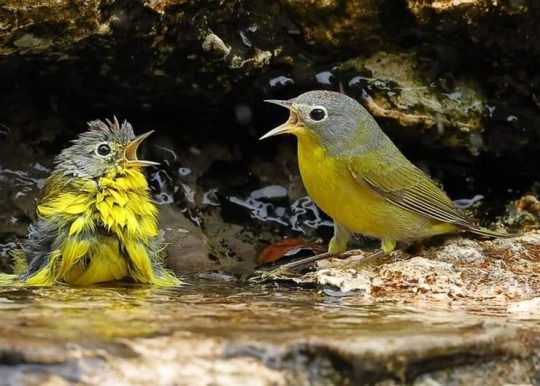
Nashville Warblers (Leiothlypis ruficapilla), BATH TIME!!!, family Parulidae, order Passeriformes, Guadalupe River State Park, Central TX, USA
photograph by Ed Means
#wood warbler#warbler#parulidae#leiothlypis#passeriformes#bird#ornithology#animals#nature#north america
2K notes
·
View notes
Text
Genus: Peucedramus

Olive Warbler (Ron Knight)
A bit of a confusing outlier, the Olive Warbler was placed originally in Parulidae until 1998, although there were multiple papers arguing for the species to be split out as early as 1962. And it seems for good reason! While I won't copy-quote or even try to summarize every little difference between wood warblers and the Olive Warbler, a huge reason is the fact that Peucedramus has 10 primary feathers while Parulidae only has 9. Even though their 10th feather is reduced in size, it's still an entire extra feather, and that trait alone splits a lot of birds into differing families. You don't randomly have an extra feather, you know?
In order to distance this species from the warbler family, there has been a push to change the name to Ocotero, a Spanish name derived from ocote, the Spanish term for many species of Latin American pines. This name lines up well with the scientific name Peucedramas, which is derived from peuke 'pine-tree' and dromos 'runner'. The change was proposed in 2019 (pdf link) and was denied by the American Ornithological Society (AOS), likely because they do not change common names unless absolutely necessary.
25 notes
·
View notes
Text

Family Parulidae
Hermit Warbler
Females look like juveniles. They're mostly gray where on the males it is a striking black. Males have white splotches on the otherwise dark gray wing while females are just plain light gray.
22 notes
·
View notes
Text

Picture(s) of the Day: Yellow-throated Warbler
Setophaga dominica
ORDER: Passeriformes
FAMILY: Parulidae
I really get excited when he shows up. I've heard him this Spring but haven't yet seen him.
3 notes
·
View notes
